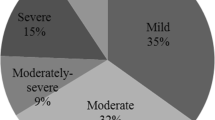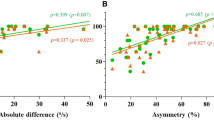Abstract
Postural stability maintenance was investigated in patients with “idiopathic” benign paroxysmal positional vertigo of the posterior semicircular canal (BPPV-PSC) and compared to healthy subjects. To measure the postural stability during a quiet upright stance, we used static posturography in two conditions: with open and with closed eyes. The effect of the repositioning Epley’s maneuver on the recovery of postural stability in patients with different durations of BPPV-PSC less than 60 days after the first attack of positioning vertigo (group I) and more than 60 days (group II) was examined. The investigation was made 1 h after the positive Dix-Hallpike test and 7 days after treatment with the Epley maneuver. “Sway velocity” (SV) and “relative power spectrum” (RPS) of the stabilograms were calculated to evaluate the postural stability for each subject and each experimental condition. We found a pronounced spectral density peak in the frequency range of 1.0–2.0 Hz and smaller spectral density in the range of 0.15–0.5 Hz compared to that in healthy subjects. Our results showed that the postural maintenance in BPPV-PSC patients depended on the disease duration. Patients with a duration of BPPV symptoms less than 60 days after the first attack demonstrated a high dependence on the visual input for postural stability. One week after the Epley maneuver, differences in the recovery of postural control in both groups of patients were also found. We assume that the disturbed otolith function together with the impaired dynamics of the semicircular canal generate a particular pattern of postural maintenance. The different degree of restoration of postural stability 1 week after the EM treatment in BPPV-PSC patients with different durations of the disease gives us reason to believe that after removing the otoconia from the semicircular canal, some stimulation of other sensory subsystems and adaptation mechanisms occur that lead to a new pattern of postural maintenance.


Similar content being viewed by others
References
Barber HO, Leigh RJ (1988) Benign (and not so benign) postural vertigo: diagnosis and treatment. In: Barber HO, Sharpe A (eds) Vestibular disorders. CRC Press, Boca Raton, pp 215–232
Beynon GJ, Baguley DM, da Cruz MJ (2000) Recurrence of symptoms following treatment of posterior semicircular canal benign positional paroxysmal vertigo with a particle repositioning maneuver. J. Otolaryngol 29:2–6
Blatt PJ, Georgakakis GA, Herman SJ, Glendaniel RA, Tusa RJ (2000) The effect of the canalith repositioning maneuver on resolving of postural instability in patients with benign paroxysmal position vertigo. Am J Otol 21:356–363
Cohen HS, Kimball KT (2004) Treatment variations on the Epley maneuver for benign paroxysmal positional vertigo. Am J Otolaryngol 25:33–37
Dix MR, Hallpike C (1952) The pathology, symptomatology and diagnosis of certain common disorders of the vestibular system. Proc R Soc Med 45:341–354
Dichgans J, Mauritz KH, Allum J, Brandt T (1976) Postural sway in normals and atactic patients: analysis of stabilizing and destabilizing effects of vision. Agressologie 17:15–24
Di Girolamo S, Paludetti G, Briglia G, Cosenza A, Santarelli R, Di Nardo W (1998) Postural control in benign paroxysmal positional vertigo before and after recovery. Acta Otolaryngol (Stockh) 118:289–293
Di Girolamo S, Ottaviani F, Scarano E, Picciotti P, Di Nardo W (2000) Postural control in horizontal benign paroxysmal positional vertigo. Eur Arch Otorhinolaryngol 257:372–375
Epley JM (1992) The canalith repositioning procedure for treatment of benign paroxysmal positional vertigo. Otolaryngol Head Neck Surg 107:399–404
Epley JM (2001) Human experience with canalith repositioning maneuvers. Ann NY Acad Sci 942:179–191
Giacomini P, Alessandrini M, Magrini A (2002) Long-term postural abnormalities in benign paroxysmal positional vertigo. J Otorhinolaryngol 64:237–241
Granat MH, Kirkwood C, Andrews B (1990) Problem with the use of total distance traveled and average speed as measures of postural sway. J Med Biol Eng Comput 28:601–602
Johansson R, Magnusson M (1991) Human postural dynamics CRC. Crit Rev Biomed Eng 18:413–437
Hall SF, Rub YR, McClure JA (1976) The mechanics of benign paroxysmal vertigo. J Otolaryngol 8:151–158
Harvey SA, Hain TC, Adamiec LC (1994) Modified liberatory maneuver: effective treatment for benign paroxysmal positional vertigo. Laryngoscope 104:1206–1212
Herdman SJ, Tusa RJ, Zee DS, Proctor LR, Mattox DE (1993) Single treatment approach to benign paroxysmal positional vertigo. Arch Otolaryngol Head Neck Surg 119:450–454
Katsarkas A, Kearney R (1990) Postural disturbances in paroxysmal positional vertigo. Am J Otol 11:444–446
Marciano E, Marcelli V (2002) Postural restruction in labyrintholithiasis. Eur Arch Otorhinolaryngol 259:262–265
Markham CH, Diamond SG, Ito J (1987) Utricular dysfunction in benign paroxysmal vertigo. In: Graham MD, Kemink JL (eds) The vestibular system: neurophysiology and clinical research. Raven Press, New York
Nashner LM (1971) A model describing vestibular detection of body sway motion. Acta Otolaryngol 72:429–436
Parnes LS, Price-Jones RG (1993) Particle repositioning maneuver for benign paroxysmal positional vertigo. Ann Otol Rhinol Laryngol 102:325–331
Popivanov D, Todirov A (1978) Statistical procedures for interference EMG power spectra estimation. J Med Biol Eng Comput 24:344–350
Prieto T, Hoffmann R, Lovett E, Myklebust M (1996) Measures of postural steadiness: differences between healthy young and elderly adults. IEEE Transaction on Biomed Eng 43:956–966
Ratcheva T, Stambolieva K, Kostadinov K (1999) Posturograph with position-sensitive detector and method for its preparing. BG patent no. 61749
Roll JP, Vedel JP, Roll R (1989) Eye, head and skeletal muscle feedback in the elaboration of body references. Prog Brain Res 80:113–123
Semont A, Freyss G, Vitte E (1988) Curing the BPPV with a libratory maneuver. Adv Otolaryngol 42:290–293
Schuknecht HF, Ruby RR (1973) Cupulolithiasis. Adv Otorhinolaryngol 20:434–443
Scott DE, Dzendolet E (1972) Quantification of sway in standing humans. Agressologie 13(B):35–40
Simhadri S, Panda N, Raghunathan M (2003) Efficacy of particle repositioning maneuver in BPPV: a prospective study. Am J.Otolaryngol 24:355–360
Stambolieva K, Racheva T, Kostadinov K (1998) Posturographic system with position-sensitive detector of registration. Proc 7th International Conference “Electronics’98,” book 3:45–50
Welling DB, Parnes LS, O’Brien B, Bakaletz LO, Lrackman DE, Hinojosa R (1997) Particulate matter in the posterior semicircular canal. Laryngoscope 107:90–94
Author information
Authors and Affiliations
Corresponding author
Rights and permissions
About this article
Cite this article
Stambolieva, K., Angov, G. Postural stability in patients with different durations of benign paroxysmal positional vertigo. Eur Arch Otorhinolaryngol 263, 118–122 (2006). https://doi.org/10.1007/s00405-005-0971-9
Received:
Accepted:
Published:
Issue Date:
DOI: https://doi.org/10.1007/s00405-005-0971-9




